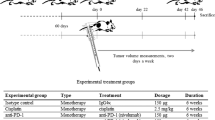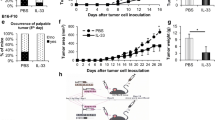Abstract
The mechanism of therapeutic activity for recombinant murine interferon-γ(rMu IFNγ) in the treatment of metastatic disease was investigated by comparing effector cell augmentation with therapeutic activity in mice bearing experimental lung metastases (B16-BL6 melanoma). Effector cell functions in spleen, peripheral blood, and lung (the tumor-bearing organ) were tested after 1 week and 3 weeks of rMu IFNγ administration (i.v. three times per week). Natural killer (NK), lymphokine-activated killer (LAK), cytolytic T lymphocyte (CTL) activities against specific and nonspecific targets, and macrophage tumoristatic activity were measured. rMu IFNγ demonstrated immunomodulatory activity in most assays of immune function. The optimal therapeutic protocol of rMu IFNγ (2.5×106 U/kg, three times per week) prolonged survival and decreased the number of pulmonary metastatic foci. This therapeutic activity was correlated with specific CTL activity from pulmonary parenchymal mononuclear cells (PPMC), but not from spleen or blood. Macrophage tumoristatic activity in PPMC also correlated with therapeutic activity, but activity in alveolar macrophages did not. However, therapeutic activity did not correlate with NK or LAK activity at any site. These results demonstrate that the optimal therapeutic protocol is the same as the optimal immunomodulatory dose for pulmonary CTL and macrophage activities. Furthermore, while immunological monitoring may help to optimize treatment protocols, current monitoring procedures that use readily accessible sites, particularly peripheral blood, may not accurately predict the therapeutic efficacy of biological response modifiers in clinical trials.
Similar content being viewed by others
References
Black PL, Phillips H, Tribble HR, Pennington R, Schneider M, Talmadge JE (1988) Correlation of immunomodulatory and therapeutic activities of interferon and interferon inducers. J Cell Biochem 36: 377
Burg M van der, Edelstein M, Gerlis L, Liang C-M, Hirschi M, Dawson A (1985) Recombinant interferon-gamma (Immuneron): results of a phase I trial in patients with cancer. J Biol Response Mod 4: 264
Djeu JY, Heinbaugh JA, Holden HT, Herberman RB (1979) Augmentation of mouse natural killer cell activity by interferon and interferon inducers. J Immunol 122: 175
Dunn TB, Patter MJ (1957) A transplantable mast cell neoplasm in the mouse. J Natl Cancer Inst 18: 587
Ernstoff MS, Reich S, Nishoda Y, Kirkwood JM (1985) Immunological assessment of melanoma patients treated with recombinant interferon gamma (rIFN-gamma, Biogen, Inc., Cambridge, MA) Immunology 26: 280
Fidler IJ, Raz A (1981) The induction of tumoricidal capacities in mouse and rat macrophages by lymphokines. Lymphokines 3: 345
Foon KA, Sherwin SA, Abrams PG, Stevenson HG, Holmes P, Maluish AE, Oldham RK, Herberman RB (1985) A phase I trial of recombinant gamma interferon in patients with cancer. Cancer Immunol Immunother 20: 193
Gidlund M, Orn A, Wigzell H, Senik A, Gresser I (1978) Enhanced NK cell activity in mice injected with interferon and interferon inducers. Nature 273: 759
Handa K, Suzuki R, Matsui H, Shimizu Y, Kumagai K (1983) Natural killer (NK) cells as a responder to interleukin 2 (IL 2). II. IL 2 induced interferon-gamma production. J Immunol 130: 988
Hart IR (1979) The selection and characterization of an invasive variant of B16 melanoma. Am J Pathol 97: 587
Hartmann D, Adams JS, Meeker AK, Schneider MS, Lenz BF, Talmadge JE (1985) Dissociation of therapeutic and toxic effects of polyinosinic-polycytidylic acid admixed with poly-l-Lysine and solubilized with carboxymethyl cellulose in tumor-bearing mice. Cancer Res 46: 1331
Hawrylowicz CM, Rees RC, Hancock BW, Potter CW (1982) Depressed spontaneous natural killing and interferon augmentation in patients with malignant lymphoma. Eur J Cancer Clin Oncol 18: 1081
Jaffe HS, Herberman RB (1988) Rationale for recombinant human IFN-γ adjuvant immunotherapy for cancer. J Natl Cancer Inst 80: 616
Kasahara T, Hooks JJ, Dougherty SF, Oppenheim JJ (1983) Interleukin 2-mediated immune interferon (IFN-gamma) production by human T cells and T cell subsets. J Immunol 130: 1784
Kawase I, Brooks CG, Kuribayashi K, Olabuenaga S, Newman W, Gillis S, Henney CS (1983) Interleukin 2 induces interferon production: participation of macrophages and NK-like cells. J Immunol 131: 288
Kirkwood JM, Ernstoff MS (1984) Interferons in the treatment of human cancer. J Clin Oncol 2: 336
Klein E, Klein G (1964) Antigenic properties of lymphomas induced by the Moloney agent. J Natl Cancer Inst 32: 547
Kleinerman ES, Kurzrock R, Wyatt D, Quesada JR, Gutterman JU, Fidler IG (1986) Activation or suppression of the tumoricidal properties of monocytes from cancer patients following treatment with human recombinant γ-interferon. Cancer Res 46: 5401
Kurzrock R, Rosenblum MG, Sherwin SA, Rios A, Talpaz M, Quesada JR, Gutterman JU (1985) Pharmacokinetics, single-dose tolerance, and biological activity of recombinant gamma-interferon in cancer patients. Cancer Res 45: 2866
Kurzrock R, Quesada JR, Talpaz M, Hersh EM, Reuben JM, Sherwin SA, Gutterman JU (1986) Phase I study of multiple dose intramuscularly administered recombinant gamma interferon. J Clin Oncol 4: 1101
Malik STA, Knowles RG, East N, Lando D, Stamp G, Balkwill FR (1991) Antitumor activity of γ-interferon in ascitic and solid tumor models of human ovarian cancer. Cancer Res 51: 6643
Maluish AE, Urba WJ, Longo DLO, Overton WR, Coggin D, Crisp ER, Williams R, Sherwin SA, Gordon K, Steis RG (1988) The determination of an immunologically active dose of interferon-gamma in patients with melanoma. J Clin Oncol 6: 434
Meltzer MS (1981) Tumor cytotoxicity by lymphokine-activated macrophages: development of macrophage tumoricidal activity requires a sequence of reactions. Lymphokines 3: 319
Munakata T, Semba U, Shibuya Y, Kuwano K, Akagi M, Arai S (1985) Induction of interferon-gamma production by human natural killer cells stimulated by hydrogen peroxide. J Immunol 134: 2449
Nathan CF, Murray HW, Wiebe ME, Rubin BY (1983) Identification of interferon-γ as the lymphokine that activates human macrophage oxidative metabolism and antimicrobial activity. J Exp Med 158: 670
Nathan CF, Horowitz CR, Harpe J de la, Vadhan-Raj S, Sherwin SA, Oettgen HF, Krown SE (1985) Administration of recombinant interferon-γ to cancer patients enhances monocyte secretion of hydrogen peroxide. Proc Natl Acad Sci USA 82: 8686
Pearlstein KT, Palladino MA, Welte K, Vilcek J (1983) Purified human interleukin 2 enhances induction of immune interferon. Cell Immunol 80: 1
Rinehart JJ, Malspeis L, Young D, Neidhart JA (1986) Phase I–II trial of human recombinant interferon gamma in renal cell carcinoma. J Biol Response Mod 5: 300
Romano PJ, Lipton A, Harvey HA, Bartholomew MJ, Giudice G, Kloszewski F, Witkowski L, Downing MR (1989) Immunologic monitoring studies in advanced cancer patients treated with recombinant human gamma interferon (IFNγ4A). Mol Biother 1: 208
Rubin BY, Gupta SL (1980) Differential efficacies of human type I and type II interferons as antiviral and antiproliferative agents. Proc Natl Acad Sci USA 77: 5928
Schreiber RD, Hicks LJ, Celada A, Buchmeier NA, Gray PW (1985) Monoclonal antibodies to murine gamma-interferon which differentially modulate macrophage activation and antiviral activity. J Immunol 134: 1609
Sherwin SA, Foon KA, Abrams PG, Heyman MR, Ochs JJ, Watson T, Maluish A, Oldham RK (1984) A preliminary phase I trial of partially purified interferon-gamma in patients with cancer. J Biol Response Mod 3: 599
Snedecor GW, Cochran WG (1967) Statistical methods. Iowa State University Press, Ames
Spina CA, Fahey JL, Durkos-Smith D, Dorey F, Sarna G (1983) Suppression of natural killer cell cytotoxicity in the peripheral blood of patients receiving interferon therapy. J Biol Response Mod 2: 458
Talmadge JE, Fidler IJ (1982) Enhanced metastatic potential of tumor cells harvested from spontaneous metastases of heterogeneous murine tumors. J Natl Cancer Inst 69: 975
Talmadge JE, Fidler IJ, Oldham RK (1985) Screening for biological response modifiers: methods and rationale. Nijhoff, Boston
Talmadge JE, Herberman RB, Chirigos MA, Maluish AE, Schneider MA, Adams JS, Phillips H, Thurman GB (1985) Hyporesponsiveness to augmentation of murine natural killer cell activity in different anatomical compartments by multiple injections of various immunomodulators including recombinant interferons and interleukin 2. J Immunol 135: 2483
Talmadge JE, Tribble HR, Pennington RW, Phillips H, Wiltrout RH (1987) Immunomodulatory and immunotherapeutic properties of recombinant gamma interferon and recombinant tumor necrosis factor in mice. Cancer Res 47: 2563
Thompson JA, Cox WW, Lindgren CG, Collins C, Neraas KA, Bonnem EA, Fefer A (1987) Subcutaneous recombinant gamma interferon in cancer patients: toxicity, pharmacokinetics, and immunomodulatory effects. Cancer Immunol Immunother 25: 47
Todd PA, Goa KL (1992) Interferon gamma. A review of its pharmacology and therapeutic potential in chronic granulomatous disease. Drugs 43: 111
Vadhan-Raj S, Al-Katib A, Bhalla R, Pelus L, Nathan CF, Sherwin SA, Oettgen HF, Krown SE (1986) Phase I trial of recombinant interferon gamma in cancer patients. J Clin Oncol 4: 137
Varesio L, Blasi E, Thurman GB, Talmadge JE, Wiltrout RH, Herberman RB (1984) Potent activation of mouse macrophages by recombinant interferon-gamma. Cancer Res 44: 4465
Weigent DA, Stanton GJ, Johnson HJ (1983) Interleukin 2 enhances natural killer cell activity through induction of gamma interferon. Infect Immun 41: 992
Woodman RC, Erickson RW, Rae J, Jaffe HS, Curnutte JT (1992) Prolonged recombinant interferon gamma therapy in chronic granulomatous disease: evidence against enhanced neutrophil oxidase activity. Blood 79: 1558
Author information
Authors and Affiliations
Additional information
By acceptance of this article, the publisher or recipient acknowledges the right of the US. Government to retain a nonexclusive, royalty-free license in and to any copyright covering the article
This research was sponsored by the DHHS, under contract N01-23910 with Program Resources Inc. The contents of this publication do not necessarily reflect the views or policies of the Department of Health and Human Services, nor does mention of trade names, commercial products, or organizations imply endorsement by the US Government
Rights and permissions
About this article
Cite this article
Black, P.L., Phillips, H., Tribble, H.R. et al. Antitumor response to recombinant murine interferon γ correlates with enhanced immune function of organ-associated, but not recirculating cytolytic T lymphocytes and macrophages. Cancer Immunol Immunother 37, 299–306 (1993). https://doi.org/10.1007/BF01518452
Received:
Accepted:
Issue Date:
DOI: https://doi.org/10.1007/BF01518452




